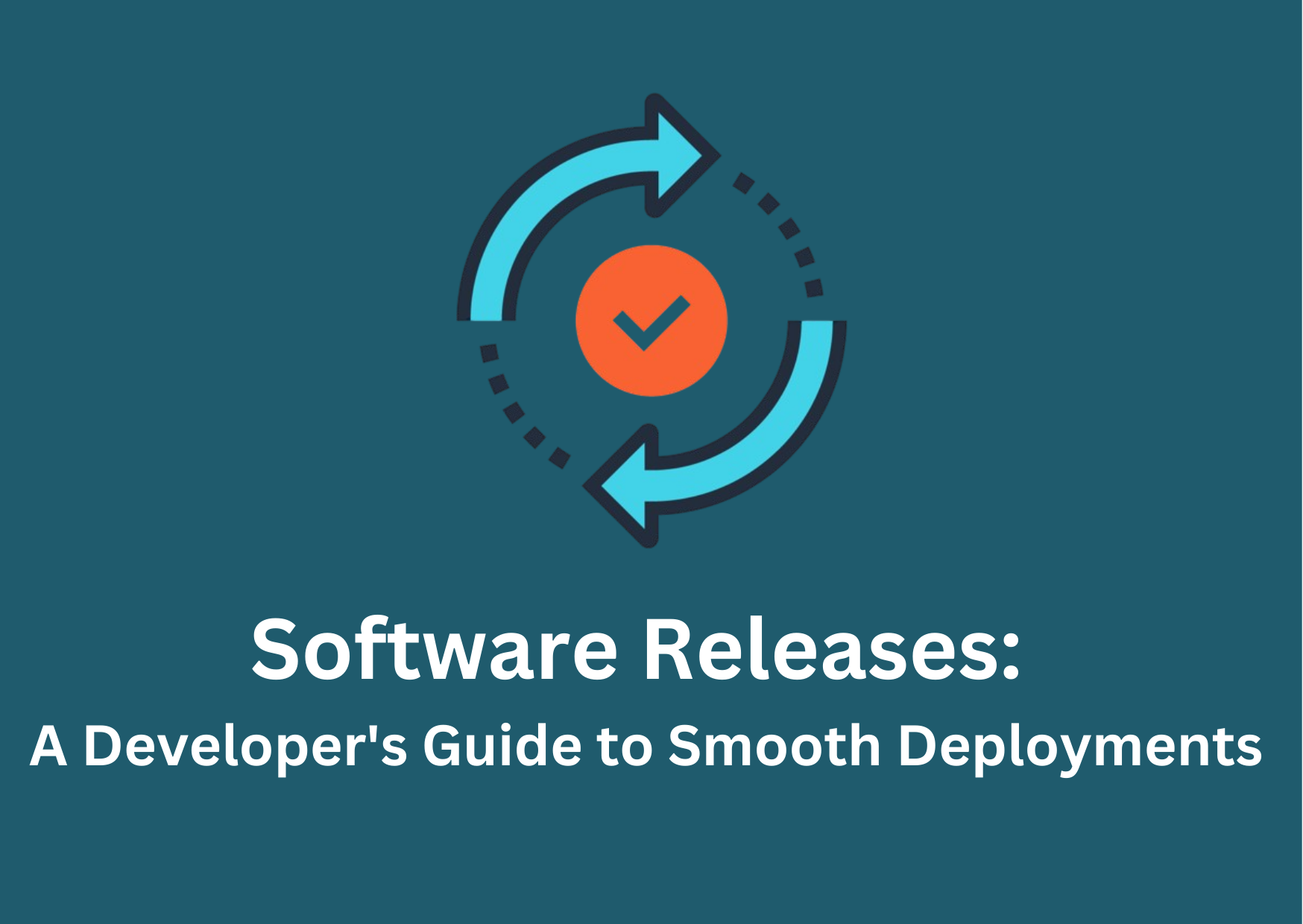Software Releases: A Developer's Guide to Smooth Deployments
 Rowland Adimoha
Rowland Adimoha
Imagine pushing a critical update that brings down your entire production system. Now imagine having the confidence to roll back that change in seconds. This is the power of effective software release management. In today's fast-paced tech world, where 84% of organizations have adopted DevOps practices (State of DevOps Report 2023), mastering release management is no longer optional—it's essential.
This guide will walk you through proven techniques for managing software releases, using a Go application with the Gin framework as our case study. Whether you're a seasoned DevOps professional or a developer looking to level up your skills, you'll find actionable insights to enhance your release strategy.
Table of Contents
The Foundations: Versioning Your Application
Environment Management: From Development to Production
Deployment Strategies: Blue-Green and Beyond
The Safety Net: Mastering Rollbacks
DevOps and Developer Collaboration: Bridging the Gap
Monitoring and Metrics: The Key to Continuous Improvement
Quick Start Guide: 5 Steps to Better Releases
1. The Foundations: Versioning Your Application
Effective versioning is the bedrock of successful release management. It's not just about keeping track of changes; it's about communicating clearly with your team and users about what to expect.
Semantic Versioning: Your New Best Friend
Semantic Versioning (SemVer) provides a clear structure for version numbers: MAJOR.MINOR.PATCH. Here's how it works:
MAJOR: Incremented for incompatible API changes.
MINOR: Added for new features in a backwards-compatible manner.
PATCH: Incremented for backwards-compatible bug fixes.
Let's implement this in our Go application:
// version.go
package main
const (
Version = "1.2.3"
BuildDate = "2024-08-12"
)
Now, let's use this in our Gin application:
// main.go
package main
import (
"github.com/gin-gonic/gin"
"net/http"
)
func main() {
r := gin.Default()
r.GET("/version", func(c *gin.Context) {
c.JSON(http.StatusOK, gin.H{
"version": Version,
"buildDate": BuildDate,
})
})
r.Run()
}
Pro Tip: Include versioning details in your configuration files for easy reference:
# config.yaml
version: "1.2.3"
buildDate: "2024-08-12"
By implementing clear versioning, you're not just organizing your code—you're setting the stage for smoother releases and easier troubleshooting down the line.
2. Environment Management: From Development to Production
Managing different environments is crucial for ensuring stability and smooth transitions. Let's explore how to set up and manage feature, development, staging, and production environments effectively.
Feature Environment: Where Innovation Thrives
Purpose: Develop and test new features separately. Best Practice: Use feature flags to enable or disable features dynamically.
# feature-flags.yaml
features:
newPaymentGateway:
enabled: true
betaUserInterface:
enabled: false
Development Environment: The Integration Playground
Purpose: Integrate and test code changes before staging. Best Practice: Mirror production as closely as possible.
# dev-config.yaml
database:
host: dev-db.example.com
port: 5432
logging:
level: debug
Staging Environment: The Dress Rehearsal
Purpose: Test releases in a production-like setting. Best Practice: Perform extensive testing, including load and performance tests.
# staging-config.yaml
database:
host: staging-db.example.com
port: 5432
logging:
level: info
Production Environment: Where Performance Meets Reliability
Purpose: Serve live traffic with the highest stability requirements. Best Practice: Implement robust monitoring and quick rollback capabilities.
# prod-config.yaml
database:
host: prod-db.example.com
port: 5432
logging:
level: warn
By clearly defining and managing these environments, you create a pipeline that nurtures innovation while safeguarding stability.
3. Deployment Strategies: Blue-Green and Beyond
Now that we have our environments set up, let's explore deployment strategies that minimize downtime and risk.
Blue-Green Deployment: The Art of Seamless Transitions
Blue-green deployment uses two identical production environments, allowing you to switch between them with zero downtime.
Here's how it works:
Deploy the new version to the "Green" environment.
Run tests on the Green environment.
Switch traffic from Blue to Green.
Keep Blue as a quick rollback option.
Let's see this in action with a Kubernetes configuration:
# blue-green-deployment.yaml
apiVersion: apps/v1
kind: Deployment
metadata:
name: my-app-green
spec:
replicas: 3
selector:
matchLabels:
app: my-app
environment: green
template:
metadata:
labels:
app: my-app
environment: green
spec:
containers:
- name: my-app
image: my-app:1.2.3-green
ports:
- containerPort: 8080
---
apiVersion: v1
kind: Service
metadata:
name: my-app-service
spec:
selector:
app: my-app
environment: green
ports:
- port: 8080
By implementing blue-green deployment, you can reduce downtime to near-zero and increase confidence in your releases.
4. The Safety Net: Mastering Rollbacks
Even with the best preparation, things can go wrong. That's where rollbacks come in. Let's explore how to implement effective rollback strategies.
Preparation: The Key to Quick Recovery
Maintain detailed version history in your version control system.
Implement comprehensive automated tests to catch issues early.
Instant Rollback: The Quick Switch
In a blue-green setup, rolling back can be as simple as redirecting traffic back to the "Blue" environment:
# rollback-service.yaml
apiVersion: v1
kind: Service
metadata:
name: my-app-service
spec:
selector:
app: my-app
environment: blue # Switch back to blue
ports:
- port: 8080
Advanced Rollback Techniques
Canary Releases: Gradually release changes to a subset of users.
Feature Toggles: Switch features on/off without redeploying.
# canary-deployment.yaml
apiVersion: apps/v1
kind: Deployment
metadata:
name: my-app-canary
spec:
replicas: 1 # Start with a small subset
selector:
matchLabels:
app: my-app
environment: canary
template:
metadata:
labels:
app: my-app
environment: canary
spec:
containers:
- name: my-app
image: my-app:1.2.3-canary
ports:
- containerPort: 8080
By implementing these rollback strategies, you create a safety net that allows you to move fast without breaking things.
5. DevOps and Developer Collaboration: Bridging the Gap
Effective release management isn't just about tools and techniques—it's about people working together seamlessly. Here's how to foster collaboration between DevOps and development teams.
Integrated Workflows: Communication is Key
Use tools like Slack or Microsoft Teams for real-time discussions.
Align goals and metrics. Both teams should work towards common objectives like stability, performance, and user satisfaction.
Automated CI/CD Pipelines: The Backbone of Collaboration
Implement robust Continuous Integration (CI) and Continuous Deployment (CD) pipelines:
# .github/workflows/ci-cd.yml
name: CI/CD Pipeline
on:
push:
branches:
- main
jobs:
build-and-test:
runs-on: ubuntu-latest
steps:
- uses: actions/checkout@v2
- name: Set up Go
uses: actions/setup-go@v2
with:
go-version: '1.20'
- name: Build
run: go build -v ./...
- name: Test
run: go test -v ./...
deploy:
needs: build-and-test
runs-on: ubuntu-latest
steps:
- name: Deploy to Kubernetes
run: |
kubectl apply -f blue-green-deployment.yaml
kubectl apply -f prod-config.yaml
Feedback Loops: Continuous Improvement
Conduct post-deployment reviews to gather insights and identify areas for improvement.
Collaborate on incident management and post-mortems to refine processes and prevent future issues.
By fostering this collaboration, you create a culture of shared responsibility and continuous improvement.
6. Monitoring and Metrics: The Key to Continuous Improvement
Effective monitoring ensures you understand the impact of releases and catch issues early. Let's explore how to set up robust monitoring.
Monitoring Tools: Your Eyes and Ears in Production
Prometheus: For metrics collection and alerting.
Grafana: For visualizing metrics and creating dashboards.
Prometheus Configuration:
# prometheus.yml
scrape_configs:
- job_name: 'my-app'
static_configs:
- targets: ['localhost:9090']
Grafana Dashboard:
{
"dashboard": {
"id": null,
"uid":
"my-app-dashboard",
"title": "My App Dashboard",
"panels": [
{
"type": "graph",
"title": "Request Rate",
"targets": [
{
"expr": "rate(http_requests_total[5m])",
"interval": "",
"format": "time_series"
}
]
}
]
}
}
Real-Time Monitoring: Staying Ahead of Issues
Set up alerts for critical metrics like error rates and response times.
Continuously monitor application performance and user experience.
By implementing robust monitoring, you gain the insights needed to make data-driven decisions about your releases.
7. Quick Start Guide: 5 Steps to Better Releases
Ready to level up your release management? Here are five steps you can take today:
Implement Semantic Versioning in your next commit.
Set up a basic blue-green deployment for one of your services.
Create a simple feature flag system to toggle new features.
Establish a regular "release retrospective" meeting with your team.
Set up basic monitoring with Prometheus and Grafana.
Conclusion: Empowering Your Release Strategy
Mastering software releases is a journey, not a destination. By implementing these techniques—from versioning to monitoring—you're not just improving your deployment process. You're building confidence, reducing stress, and creating space for innovation.
Remember, the goal isn't perfection but continuous improvement. Start small, learn from each release, and gradually refine your process. With these tools and strategies at your disposal, you're well-equipped to navigate the complexities of modern software development.
This technique, while widely applicable across various platforms like Azure, AWS, GCP, and other cloud environments, is valuable for any setting where minimizing downtime and maintaining application stability is critical. With a collaborative approach between DevOps and developers, and by integrating robust monitoring and metrics, you can navigate the complexities of software releases with confidence and precision.
References
Subscribe to my newsletter
Read articles from Rowland Adimoha directly inside your inbox. Subscribe to the newsletter, and don't miss out.
Written by
